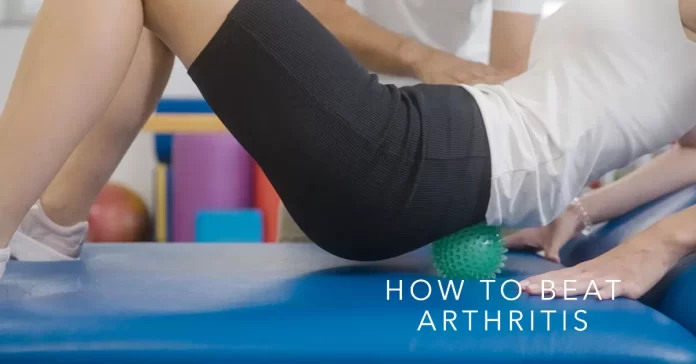Arthritis is a widespread condition that affects millions of people, causing joint pain and discomfort. While it can be challenging, there are effective ways to manage and alleviate joint pain associated with arthritis. Let’s look at some practical tips and lifestyle adjustments that can considerably improve your overall quality of life.
Understanding Arthritis
Before diving into solutions, it’s crucial to understand arthritis. It’s not a single disease but an umbrella term encompassing various joint disorders characterized by inflammation. The most common types include osteoarthritis (OA) and rheumatoid arthritis (RA).
- Osteoarthritis (OA): Osteoarthritis is frequently associated with the gradual wear and tear experienced by joints over time. It typically affects older adults and can lead to joint pain, stiffness, and decreased mobility.
- Rheumatoid Arthritis (RA): Rheumatoid Arthritis, on the other hand, is an autoimmune disease where the body’s immune system mistakenly attacks joint tissues. It can occur at any age and causes pain, swelling, and knot deformity.
Lifestyle Changes for Arthritis Management
- Maintain a Healthy Weight: Carrying excess weight places additional strain on your joints, especially in areas like the knees, hips, and spine. Losing even a little weight can significantly reduce joint pain and slow down the arthritis progression.
- Regular Exercise: While it may seem counterintuitive, regular, low-impact exercise can help improve joint function and reduce pain. Low-impact activities such as swimming, walking, and cycling are easy on the joints.
- Balanced Diet: A diet rich in anti-inflammatory foods like fruits, vegetables, whole grains, and fatty fish (rich in omega-3 fatty acids) can help manage arthritis-related inflammation.
- Hot and Cold Therapy: Applying heat or cold to affected joints can provide relief. Heat soothes and relaxes muscles, while cold reduces inflammation and numbs the area.
- Physical Therapy: Consult a physical therapist who can design a tailored exercise program to improve joint flexibility and strength.
Medications and Treatments
- Over-the-Counter Pain Relievers: Non-prescription medications like acetaminophen or nonsteroidal anti-inflammatory drugs (NSAIDs) can provide relief from arthritis pain.
- Prescription Medications: In rare cases, your doctor may prescribe strong medicine or disease-modifying antirheumatic drugs (DMARDs) for RA.
- Joint Injections: Injections of corticosteroids directly into the affected joints can offer substantial pain relief.
- Surgery: For severe cases, joint replacement surgery may be considered, especially for knee or hip arthritis.
Assistive Devices
- Braces and Splints: These can support and reduce strain on affected joints.
- Canes and Walkers: Assistive devices can help with mobility and balance.
- Joint Protection Techniques: Learning to protect your joints during daily activities can minimize pain.
Coping Strategies
- Stress Management: High stress can exacerbate arthritis symptoms. Practicing relaxation techniques like deep breathing or meditation can be beneficial.
- Support Groups: Joining arthritis support groups or connecting with others facing similar challenges can provide emotional support and valuable information.
Conclusion
Beating arthritis is a unique journey. It involves managing your weight, staying active, making smart dietary choices, exploring available treatments, and seeking emotional support when needed. Your path to better joint health begins today.
Frequently Asked Questions (FAQs)
What is arthritis, and how does it affect the joints?
Arthritis comprises a group of conditions characterized by joint inflammation and pain. It can affect any joint in the body and often leads to stiffness and reduced mobility.
Are there different types of arthritis, and how do they differ?
Osteoarthritis and rheumatoid arthritis are the most prevalent among the over 100 types of arthritis. These two types vary in their causes, symptoms, and treatment approaches.
What are the common symptoms of arthritis?
Common symptoms include joint pain, swelling, stiffness, and decreased range of motion. Some types of arthritis may also cause fatigue and systemic symptoms.
Can arthritis be prevented, or is it primarily age-related?
While some types of arthritis are age-related, there are preventive measures such as maintaining a healthy weight, staying physically active, and protecting joints from injury.
How do healthcare professionals diagnose arthritis?
Healthcare providers diagnose arthritis through physical exams, medical history, imaging tests, and sometimes blood tests to identify specific markers.
What are the most effective treatments for arthritis-related joint pain?
Treatment options for arthritis may encompass medications, physical therapy, lifestyle adjustments, and, in certain instances, surgical procedures. The choice depends on the type and severity of arthritis.
Can exercise help with arthritis, and which activities should you consider?
Exercise plays a crucial role in enhancing joint function and alleviating pain. Professionals often recommend low-impact exercises like swimming, walking, and yoga for individuals with arthritis.
Are there dietary changes or supplements that can help manage arthritis symptoms?
Some diets like the Mediterranean diet and supplements like omega-3 fatty acids and glucosamine may provide relief.
What lifestyle modifications can improve the quality of life for individuals with arthritis?
Managing stress, getting enough sleep, and using assistive devices can enhance the quality of life for those with arthritis.
How can I work with my healthcare provider to create a personalized arthritis management plan?
Collaborate with your healthcare provider to develop a plan tailored to your needs. Discuss goals, treatments, and any concerns you may have.
- What to Do If Bitten by a Dog: Steps for Rabies Prevention
- Top 10 Herbal Remedies That Combat Arthritis Inflammation
- Holistic Tonsil Care: Natural Home Remedies and Best Practices
Arthritis Research and Treatment
According to the Johns Hopkins Arthritis Center, arthritis is not one disease; it’s a label for over 100 different conditions. These conditions all have some things in common: they cause lasting joint pain, limit movement, and reduce how far you can move your joints. Arthritis is a big deal in the United States, impacting around 70 million Americans, or about one out of every three people. It’s the primary cause of disability in the country. Importantly, arthritis isn’t solely related to aging; some forms happen because the immune system goes haywire and can occur at any age. While there’s no magic cure, ongoing scientific research gives us hope for better ways to diagnose and treat it.










